All die-hard Star Trek fans have a memory of the first time their mind was blown by something in the franchise. Perhaps it was bearing witness to the first interracial kiss on television, or seeing an actor of your race or gender in a position of authority. Maybe it was a particularly moving and timely monologue, or the realization that modern technology is catching up to science fiction.
For me, one of those moments was seeing characters of mixed race portrayed for the first time, characters whose mixed backgrounds were very much a part of their identities. As a person of mixed race myself (my father is Caucasian American and my mother is Filipino), this was comforting at first. However, as I grew older and looked at these characters on a deeper level, my mind was blown again when I realized that nearly every one of these “hybrids” (the term used by Memory Alpha) was actually a “tragic mulatto.”
For those who may not know, the “tragic mulatto” is a literary archetype of a mixed-race person torn between two worlds and accepted by none. Most “tragic mulattos” (which I will refer to from now on as “tragic hybrids”) embody similar characteristics: they are usually women, and tend to be troubled, outcast, unlucky, lonely, perverse, and often die untimely or suicidal deaths. The archetype is credited to Lydia Maria Child, who wrote two short stories featuring tragic, mixed race characters in the 1840s just before the Civil War.¹ These characters were a manifestation of the belief that miscegenation was unnatural and harmful to society.
So why are there so many of them in the Star Trek universe? Many Trek characters are actually listed as examples on the Wikipedia page for the archetype. For all of Star Trek’s accomplishments regarding diversity and inclusivity, it doesn’t get everything right, and it seems that the instinct to fall back onto this archetype may have been out of ignorance. After all, TOS first aired in 1966. Interracial marriage wasn’t legal in the US until 1967’s Supreme Court case Loving vs. Virginia. In 1970, only 1% of children under the age of one were mixed race.2 This number rose to 10% by 2013,² and as more people identify as mixed race these portrayals on Star Trek feel outdated and irrelevant.
There are certainly mixed race characters portrayed as being fine with their backgrounds. Deanna Troi can pretty much pass as human or Betazoid, and she and Naomi Wildman seemingly never have internal struggles about their mixed heritage or deal with discrimination because of it. However, there are many other mixed race characters who carry one or more of the classic tragic characteristics.
Here are my top five tragic hybrids from Star Trek:
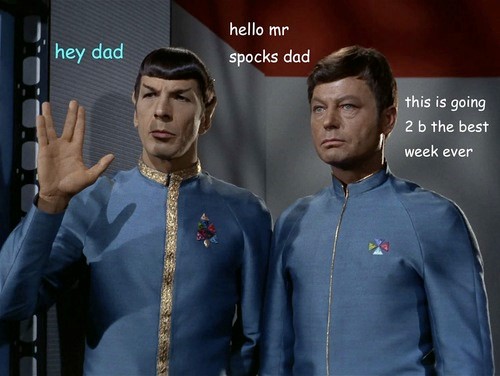
Spock (Human/Vulcan)
There’s a lot to unpack with Spock because his mixed background is covered more than any other hybrid character in the Star Trek canon. A scene depicting young Spock bullied by preteen Vulcans trying to arouse his Human emotions is included in both TAS and Star Trek (2009), and both TOS and TNG have episodes that explore Spock’s mixed background. His relationship with his parents is strained, and he finds great difficulty in pleasing either one. His father, Sarek, insists that Spock choose between Vulcan and Human cultures, a choice that many mixed race people feel compelled to make. Though Spock chooses to follow the Vulcan way of life, he is constantly torn between both sides and seeks refuge in the neutrality of Starfleet. His mother, Amanda Greyson, even comments in the TOS episode “Journey To Babel”, “Neither Human nor Vulcan, at home nowhere except Starfleet.”
Though Spock struggles throughout his life, he is still the least tragic on this list. We could call him “Vulcan passing”, as his Human traits are not physical and he has the privilege of identifying as non-hybrid to most beings he encounters. He does ultimately find a certain peace in the friendships with his Enterprise crewmates, and subsequently creates a balance in himself after the death of Sarek when he realizes the unique talents that his mixed heritage brings him. His distinctive experiences allow him to assist in the beginnings of reunifying the Vulcan and Romulan homeworlds. In the TNG episode “Unification II”, Spock says, “I always had a different vision than my father – the ability to see beyond pure logic. He considered it weak, but I have discovered it to be a source of extraordinary strength.”
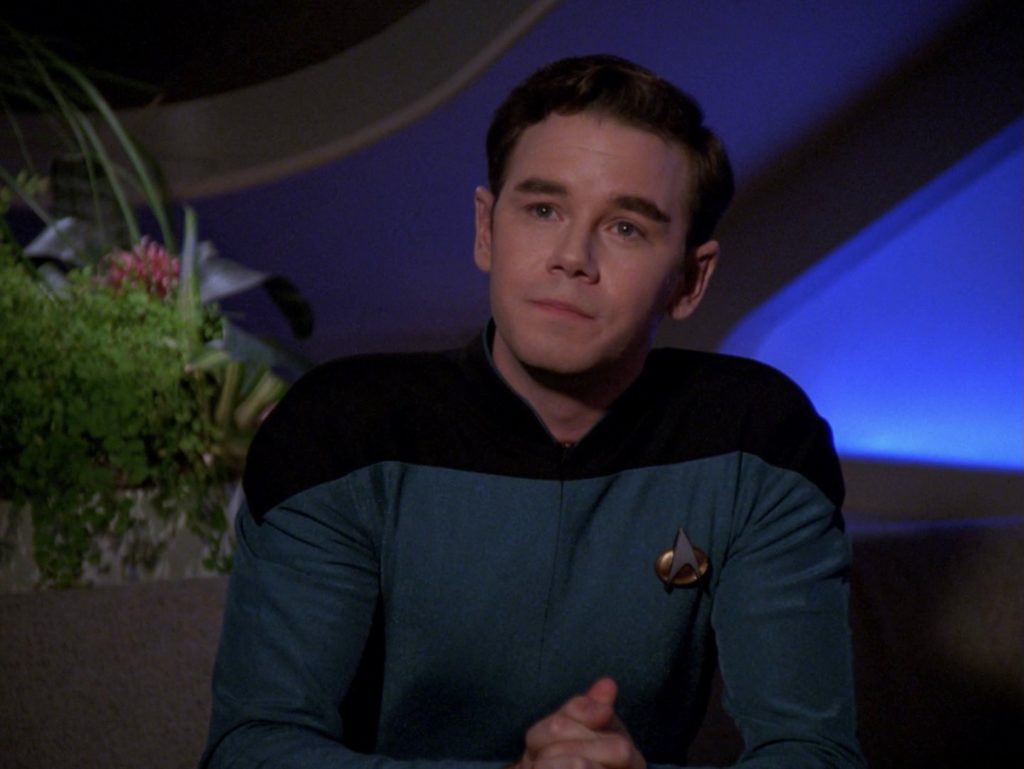
Simon Tarses (Human/Romulan)
We only meet him once, and he’s just a medical technician, but he appears in one of the most celebrated episodes of TNG, “The Drumhead”. When Admiral Satie (the incomparable Jean Simmons) is sent to the Enterprise to investigate a potential conspiracy, Simon Tarses gets swept up in the witch-hunt. This is not due to proof of his involvement, but because he lied about his Romulan heritage on his Starfleet application. In this episode, we see that racism toward the Romulan people runs rampant in the highest reaches of Starfleet. No matter what he says or does, he is seen as a spy and traitor because of his race.
To witness the inherent racism and nationalism flickering through the smooth surface of Starfleet culture feels chillingly relevant during our current political climate. I wonder what this episode would have been like if Riker had been able to question Mr. Tarses on the stand, giving him a chance to stand up for himself and maybe explore the inherent biases that put him in this position. Though nothing comes of Starfleet’s investigation of Mr. Tarses (which ends when Admiral Satie passionately reveals her true intentions during her interview with Picard), the story feels incomplete. Captain Picard calls Admiral Satie’s methods into question, but she is never truly called out for her racism, and Mr. Tarses’ real story is never told.
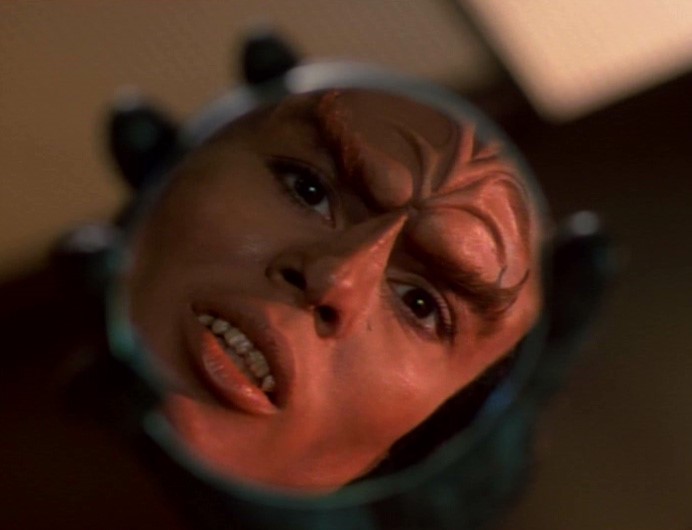
B’Elanna Torres (Human/Klingon)
B’Elanna’s self-loathing toward her Klingon side breaks my heart over and over. In the VOY episode “Lineage”, we’re shown flashbacks to a camping trip she took with her Human father, uncle, and cousins. Here we see the truth – B’Elanna’s dad is racist. Her cousin makes a deliberately offensive comment about her mother’s culture after putting a worm in her sandwich, clearly mocking a traditional Klingon dish. Her father tells her to not be so sensitive, dismissing her feelings and ignoring her cousin’s racist actions. She later overhears her father complaining about living with two Klingons.I find myself imagining how I’d feel if my white father reacted this way in a similar situation, or if I heard him say he couldn’t handle living with three Filipinos. It’s a devastating thought. Her Human father’s shame of her Klingon heritage directly affects everything B’Elanna does, including pushing away all of her friends, dropping out of Starfleet academy, joining the Maquis, and eventually re-programming The Doctor to remove all Klingon DNA from her unborn child, not to mention her devastation at the end of the episode “Faces” when her Klingon DNA must be reintegrated into her body. Though she does exhibit many tragic hybrid characteristics and never truly makes peace with her mixed race heritage, at least she finally finds happiness and a sense of balance with Tom Paris, a man who loves her as she is.
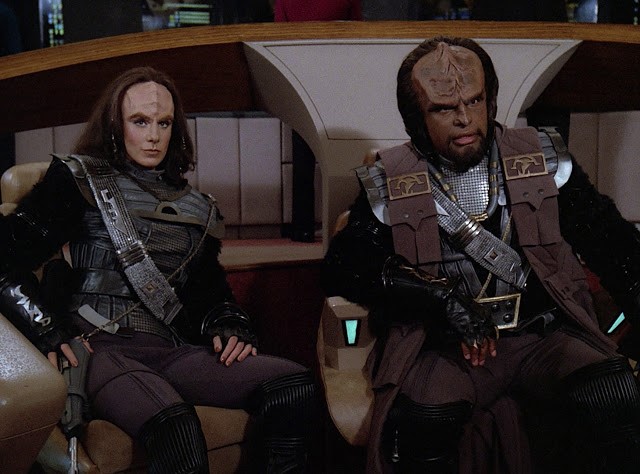
K’Ehleyr (Human/Klingon)
The only woman who ever seemed a true match for Worf (sorry, Jadzia Dax fans), K’Ehleyr embodies nearly all of the classic tragic characteristics. Though her reverence for and knowledge of Klingon culture is deep, she’s in a constant battle between her two cultures, and she always seems to get the short end of the bat’leth when it comes to her Klingon side. She and Worf first get together in TNG’s “The Emissary” after a fantastic battle romp in Worf’s monster-filled calisthenics program. He implores her to take the oath of marriage, but she refuses. She’s got his young son in tow and is ready to be with him by “Reunion”, but he can’t – in the interim he was pressured by Duras to accept dishonor in order to maintain the stability of the Empire. Klingon dishonor lasts three generations, and Alexander would be better off without Worf as the father. K’Ehleyr investigates, which leads her to Duras, who ultimately ends up murdering her for learning too much about it. She dies in Worf’s arms in front of their son, who’s now at the beginning of a pretty messed up life. It seems that every time she tries to be Klingon there are dire consequences.
Though she only appears in two episodes of TNG, the wake left by K’Ehleyr’s death is so vast and far-reaching that it affects Worf’s storyline through both TNG and DS9, making her one of the most tragic characters of all. Star Trek gave us a strong woman of mixed race who had made a career of connecting the people of her two backgrounds, who was intelligent, passionate, well rounded, and interesting, and whose strength was her confidence and unique perspective. Then they dropped her into the middle of an old mixed race literary trope and literally left her to die. She had so much potential.
I find myself fantasizing about what could have been had her character not been written as a tragic hybrid. I see her and Worf becoming the power couple that takes down the Duras family together, and I see her helping Worf look fondly upon his upbringing on Earth and finally embrace the love of his foster parents. By co-parenting Alexander, maybe father and son would have both grown to be proud of Alexander’s mixed heritage. Is there fan fiction that explores what would have happened if K’Ehleyr had lived? If not, someone please write it.
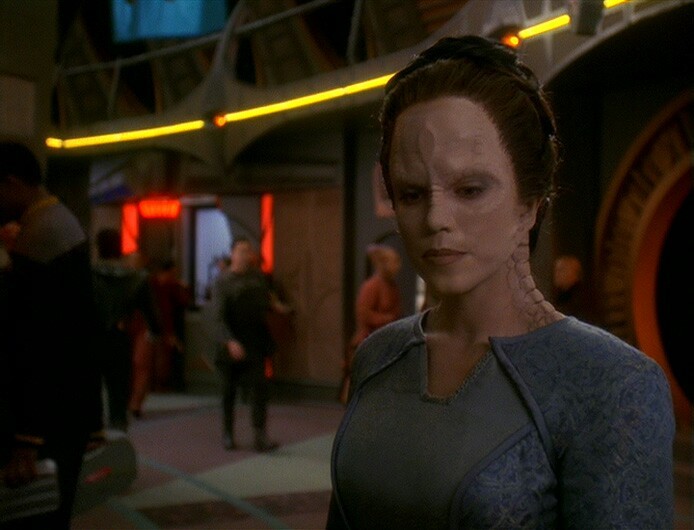
Tora Ziyal (Bajoran/Cardassian)
Ziyal is probably the closest to a perfect tragic hybrid that we get on Star Trek. Sometimes I’m afraid of how much I relate to her. Part of me sees my white ancestors like the Cardassians, especially since the Philippines was a Spanish colony for 333 years and an American colony for 35. She exists during the Cardassian occupation of Bajor and the subsequent war. I imagine it might be like if my father was Lt. General Arthur MacArthur Jr., my mother was an indigenous Filipino woman, and I was conceived during the American occupation just before the Philippine American War. Yikes.
She’s not at home on Bajor, she’s not at home on Cardassia, and she didn’t even really grow up in either place. She’s constantly pulled in two directions by her close relationships with her friend Major Kira and her villain father, Gul Dukat, each representing a different side of her background. Though she’s desperate to use her art and mixed heritage to bring people together, that dream is never realized. She’s murdered by one of Dukat’s underlings for being a traitor and dies in her father’s arms after telling him she cannot return with him to Cardassia.
Though I do think it’s dangerous to put the responsibility of unifying two race-torn cultures on the shoulders of a mixed race person (we’re not the answer to racism, guys), Ziyal was in a perfect position to make a difference. She was the daughter of a high ranking officer in the Cardassian military, close friend of a respected former member of the Bajoran resistance, lived on a former Cardassian/current Federation starbase, and had the ear of a Starfleet captain. What if Dukat’s true source of madness was Ziyal’s support of peace and Bajoran independence, and she truly became his adversary? I would much rather see her potential as a unifier realized than as a martyr whose death is only used to drive the series’ villain into making more and more destructive choices.
I very much hope that in the future, Star Trek can throw this trope by the wayside for good. The more people of mixed race exist, the more it seems that realistic versions of us are missing from futuristic science fiction. I don’t know if there will be mixed race characters on ST: Discovery, but if Lt. Commander Burnham turns out to be part Vulcan (which I am crossing my fingers for), her story better not end tragically.
1 “The Tragic Mulatto Myth” Jim Crow: Museum of Racist Memorabilia. Ferris State University.
2 Pew Research Center. 2015. “Multiracial in America: Proud, Diverse and Growing in Numbers.” Washington, D.C.: June
I recommend Denise Hurd’s 2004 paper for The Journal of Popular Culture: ‘The Monster Inside: 19th Century Racial Constructs in the 24th Century Mythos of Star Trek’. It deals with the tragic mulatto stereotype in Trek. I felt compelled to search for academic work on this question after rewatching Voyager’s season one episode, Faces. After reading Hurd’s paper I came here to see if Women at Warp had done an episode about this topic.
Something else that bugs me about how human/klingon hybrids are used in Trek is that there seems to be a sexist double standard. I strongly believe that Torres was made klingon/human because producers judged that a wholly klingon woman would not be attractive to viewers. There is some messed up colourism going on here that I would like to see someone more knowledgeable than me unpack.
What about Ba’el (Romulan father, Klingon mother) she seemed very comfortable with her heritage.
I believe B’Elanna finally found peace with her Klingon ancestry, thanks to the Klingon leader of a generational ship that Voyager had encountered in late Season Seven.
Star trek is part of
Weird runs into the weird.
Like capt ⁷Janeway said weird is what we do that is what we signedi] gor
BElanna did learn to find peace and balance over mixed heritage.
I gotta disagree with you on Tora Ziyal: she wasn’t in any position whatsoever to influence Dukat.
Remember her debut episode? Dukat planned to murder her to hide the fact he’d sired a half-Bajoran bastard on his sex slave for little more reason than to spare his own career.
Remember “By Inferno’s Light”? Dukat left her behind to die by exploding sun when she wouldn’t go back to Cardassia with him.
And during the Occupation of DS9 arc, he’s got all these expectations of how a proper daughter of a high-ranking Cardassian is supposed to behave. And it finally starts to dawn on her just what kind of a man he really is.
**SPOILER ALERT**
It’s been announced since I wrote this that Lt. Commander Burnham is Spock’s adopted sister! She is fully human, though. Maybe we’re looking at a more Worf-like story, culturally.
Thanks again for letting me write this, Women at Warp. I’m over the moon right now.